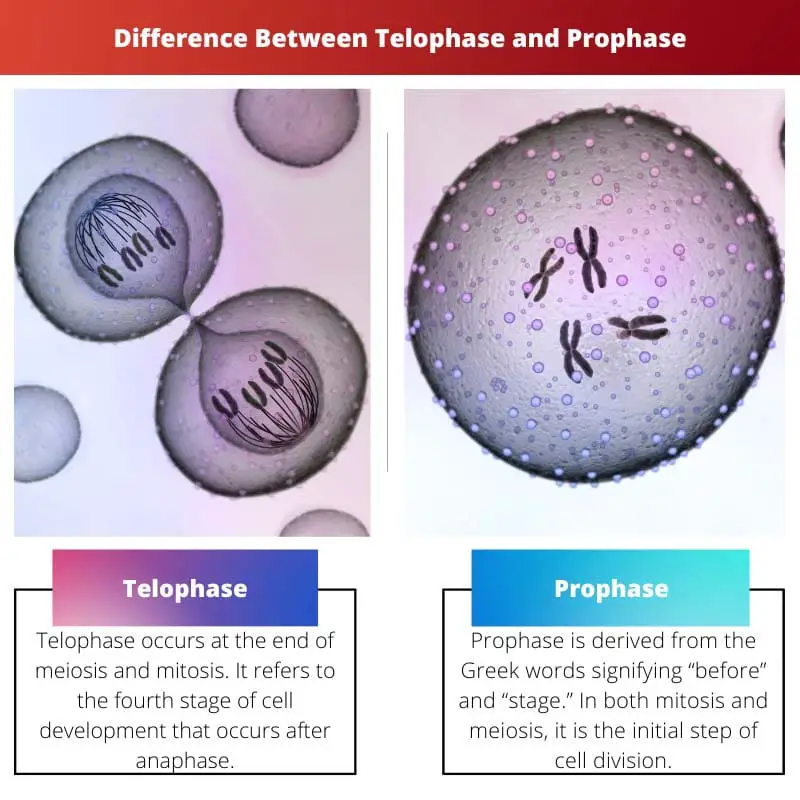Mitosis is the process by which chromosomes connect to a structure called the mitotic spindle. Mitosis is now thought to have five stages depending on the physical condition of the chromosomes and spindle.
Prophase, prometaphase, metaphase, anaphase, and telophase are those stages. Telophase occurs at the end of meiosis and mitosis, whereas prophase occurs at the beginning of mitosis.
Key Takeaways
- Prophase marks the beginning of mitosis, with chromosomes condensing and the nuclear envelope breaking down, while telophase represents the final stage of mitosis, where chromosomes decondense and nuclear envelopes reform.
- Spindle fibers shorten in telophase, pulling sister chromatids to opposite cell poles. In contrast, they start to form in prophase, providing a structure for chromosome separation later in the process.
- Cytokinesis, the division of the cytoplasm, follows telophase, resulting in two daughter cells, whereas prophase precedes metaphase, which involves chromosome alignment at the cell’s equator.
Telophase vs Prophase
Telophase is a phase of cell development. It is the fourth stage. At this phase, the daughter chromosomes started to move in the opposite direction of spindle fibres. Prophase is the first stage of cell development. Condensation of chromosomes starts to begin in the prophase. The nuclear membrane dissolved at this stage.

Telophase occurs at the end of meiosis and mitosis. It refers to the fourth stage of cell development that occurs after anaphase. Telophase occurs when the reproduced, paired chromosomes are split and dragged to opposing sides of the cell or poles.
The daughter chromosomes travel to the opposite sides of the spindle fibres at this stage.
Prophase is derived from the Greek words signifying “before” and “stage.” In both mitosis and meiosis, it is the initial step of cell division.
When the cell reaches prophase, DNA has already been duplicated beginning after interphase. When you examine under a microscope at a cell in prophase, you will notice thick strands of DNA free in the cell.
Comparison Table
| Parameters of Comparison | Telophase | Prophase |
|---|---|---|
| Stage of mitosis | Last phase | First phase |
| Process | Chromosomes decondense during telophase | Condensation of chromosomes starts during prophase |
| Nuclear membrane | Reappears | Disappears |
| Nucleolus | Reappears | Disappears |
| Chromosome’s arrangement | Opposite poles of the cell. | Randomly arranged |
| Occurrence | Haploid cells | Diploid cells |
What is Telophase?
Telophase is the fifth and final stage of mitosis, the process by which the duplicated genetic material held in the nucleus of a parent cell is separated into two identical daughter cells.
Telophase occurs when the replicated, paired chromosomes are split and dragged to opposing sides of the cell or poles. The chromosomes start to uncoil, making them more scattered and less compact.
Along with telophase, the cell goes through cytokinesis, which separates the mother cell’s cytoplasm into two daughter cells.
The chromosomes begin to decondense during telophase, the spindle disintegrates, and the nuclear membranes and nucleoli re-form.
The mother cell’s cytoplasm splits to generate two daughter cells, each with the same number and type of chromosomes as the mother cell. Interphase is the phase or period that follows the conclusion of mitosis.
Telophase is a phase that isolates the replicated genetic material that a parent cell’s nucleus carries onto two identical daughter cells.
During telophase, however, each pair of genes has a nuclear membrane around it. These are the membranes that separate the nuclear DNA from the cytoplasm.
Furthermore, the genes begin uncoiling, which causes them to disperse and reduces their influence. In addition to telophase, the cell goes through a process known as cytokinesis.
It restores the effects of prophase and pro-metaphase throughout this process. As the genes reach the cell poles, a nuclear envelope reassembles around each set of chromatids.
After then, the nucleoli return, and the texture of the genes begins to change. Then it returns to the chromatin, which grows and is present throughout the interphase.
The mitotic spindle disassembles, and the remaining spindle microtubules depolymerize (break down into monomers).
Telophase contributes around 2% of the cycle’s length. Typically, the procedure begins before the late telophase. When finished, it separates the two daughter nuclei between two different daughter cells.
The dephosphorylation of mitotic cyclin-dependent kinase substrates largely drives the telophase.

What is Prophase?
Prophase is the first step of mitosis, in which the identical genetic information held in a parental cell’s nucleus is split into two daughter cells.
The nucleus’s mix of DNA and proteins, described as chromatin, consolidates during prophase.
The chromatin coils and compacts culminate in the development of visible chromosomes. Chromosomes are made up of a single, highly structured piece of DNA.
Sister chromatids are chromosomes that have been duplicated and have an X shape. The sister chromatids are two identical DNA versions connected at a place known as the centromere.
The mitotic spindle, a structure, then begins to develop. The mitotic spindle is composed of long proteins known as microtubules, which begin to develop at opposing ends of the cell.
The spindle will be in charge of dividing the sister chromatids into two cells. Prophase is succeeded by prometaphase, the second phase of mitosis.
Meiosis requires two rounds of chromosomal segregation, resulting in two prophases, prophase I and prophase II. Since homologous chromosomes must pair and share genetic information, prophase I is the most complicated meiosis phase.
Mitotic prophase is quite comparable to prophase II. The most noticeable distinction between prophase in plant cells and animal cells is the absence of centrioles in plant cells.
Main Differences Between Telophase and Prophase
- Telophase is the last stage of mitosis, whereas prophase is the starting stage of mitosis.
- During telophase, chromosomes loosen up, whereas condensation begins in prophase.
- In telophase, a nuclear membrane forms around each set of chromosomes at the pole, whereas, in prophase, the nuclear membrane begins to dissolve.
- A nucleolus forms in each daughter nucleus during telophase, but the nucleolus begins to dissolve during prophase.
- In telophase, chromosomes are found at opposing poles of the cell, whereas in prophase, chromosomes are randomly distributed throughout the cell.
- Telophase occurs in haploid cells, meanwhile prophase occurs in diploid cells.

- https://www.sciencedirect.com/science/article/pii/S0960982206013467
- https://journals.biologists.com/jcs/article-abstract/41/1/321/65664
